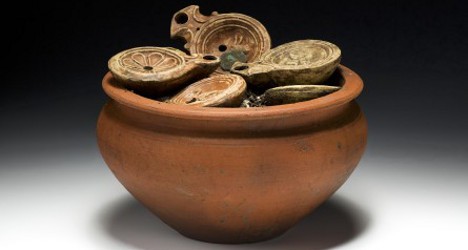AARGAU, SWITZERLAND – Archaeologists have unearthed a strange find: an earthenware pot filled with bronze coins and oil lamps, each containing a cult symbol.
It all began when an archaeological examination was called for the commune of Windisch, in the northern Swiss canton of Aargau. The authorities wanted to make sure they wouldn’t be destroying any valuable history by developing the area into shops and apartment buildings.
Previous archaeological digs in the area have uncovered quite a lot of history, mostly pertaining to the area’s very Roman past. Two-thousand years ago, the area of Aargau was home to a Roman legion camp called Vindonissa, where the town of Windisch is located now. Archaeologists have uncovered a wealth of artifacts there, and even the foundations of a few Roman-era buildings.
Yet, this new archaeological find is turning some heads.
At first, it seemed inconsequential. Earthenware pots are nothing special, especially in a Roman-era town. It’s like finding tupperware. However, it wasn’t the pot itself, but its contents that caught the researchers’ eyes. The pot is filled with twenty-two oil lamps, each home to a bronze coin.
“What astonished us was the quantity and the combination of coins and lamps,” Georg Matter, Aargau cantonal archaeologist said.
Each lamp is engraved with its own specific cult image. On one, there’s a depiction of the moon goddess, Luna. On the others, there’s a gladiator, a lion, a peacock, and an erotic scene, respectively.
What does this find mean?
Well, it’s not a treasure trove, that’s for sure. The bronze coins aren’t worth very much. The archaeologists working on the find believe they were merely a symbolic gesture. They’re not completely useless, though. Lucky for the archaeologists, the coins can easily be dated, giving us a clue as to when the burial was made.
According to the coins, the find dates to AD 66-67. This would have been during the reign of the famous Roman Emperor, Nero.
Georg Matter and his team of archaeologists suspect it’s a ritual burial, but they’re still not sure. During the early stages of research, they discovered some charred remains, but testing has revealed they’re animal bones, so the jar isn’t an urn for human remains.
“The intentions behind this burial are puzzling at the moment,” Matter remarked.
A Cult Burial
![A statue of the goddess Luna. [PHOTO: wikimedia]](https://historythings.com/wp-content/uploads/2016/11/300px-Luna_statue.jpg)
A statue of the goddess Luna. [PHOTO: wikimedia]
Luna was an essential figure in the Roman pantheon. Paired with the god of the sun, Sol, Luna and Sol commanded everything in the Roman world. Luna was essential both for agriculture, and in some stories, childbirth. Virgil referred to Luna and Sol as clarissima mundi lumina, or the world’s clearest sources of light.
The lion remains a mystery (though it could be associated with Hercules, since the demi-god is often depicted wearing the skin of a lion as a cloak), as does the gladiator. The peacock was a common symbol associated with Juno, the ‘queen of the world’, who was associated with vital force and energy, and is shown as a divine protectress and a sovereign goddess. Interestingly enough, she’s also called Lucina, and is associated with the moon, just like the goddess Luna. The erotic scene could have something to do with the goddess Venus, the Roman goddess of love.
The animal bones could be left over from a burnt sacrifice to whichever god the person who made the burial was trying to call upon. As for the lamps, it’s possible that, as a source of light, they were thought of as a connection to the goddess depicted on them, Luna, the clarissima mundi lumina. Perhaps the coins were an offering.
Whatever this strange burial means, it still remains a mystery as to why the person would have been calling on these specific gods and goddesses in such a strange, unique way. Until similar burials are unearthed in other Roman towns, or more context is uncovered, it will be impossible to determine the meaning behind the coins, the animal bones, and the lamps. The find, so far, remains a mystery.


